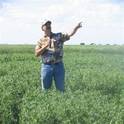
Common bean (Phaseolus vulgaris L.) is the most important source of dietary protein in Uganda but current grain yields are low. Production is particularly low on the degraded Ferralsol soils that dominate the landscape because these soils are generally weathered, acidic and infertile. A study was done on a Ferralsol soil in Masaka District, Uganda to compare productivity and economic return to labor and management (ERLM) for four bean cultivars grown under three management systems. The experimental design was a randomized complete block in a split-plot arrangement. Management system was the whole-plot factor and included the Conventional Farmer (CFS), Improved Farmer (IFS), and High Input systems (HIS). Management systems differed for seed fungicide treatment (no vs. yes), seeding density (10 vs. 20 seed m-2), plant configuration (scatter vs. rows), fertilizer applications (P, K, Ca, Mg, Zn and S), rhizobium inoculation (no vs. yes), pesticide applications (no vs. yes), and frequency and timing of weeding. Subplots were four common bean cultivars that differed for resistance to foliar pathogens and the ability to tolerate low soil fertility. Increasing management level and planting bean cultivars tolerant to common bean diseases and low soil fertility improved bean grain yield. The only grain yield differences observed were between cultivars in the 2015A season; NABE 14 had greatest grain yield, 168% greater than that of NABE 15. The HIS with NABE 14 (1274 kg ha-1), the HIS with NABE 4 (1225 kg ha-1), and the IFS with NABE 14 (1025 kg ha-1) had the greatest grain yield. The ERLM was only profitable for the CFS ($40 ha-1); cultivars did not differ. Farmers planting bean on Ferralsol soil can improve yields with higher input systems but the tested systems were not profitable.
Available at: http://works.bepress.com/andrew_lenssen/132/

This article is published as Goettsch, Lance H., Andrew W. Lenssen, Russell S. Yost, Ebby S. Luvaga, Onesmus Semalulu, Moses Tenywa, Richard Miiro, and Robert E. Mazur. "Improved production systems for common bean on Ferralsol soil in south-central Uganda." African Journal of Agricultural Research 12, no. 23 (2017): 1959-1969. doi: 10.5897/AJAR2017.12122 . Posted with permission.